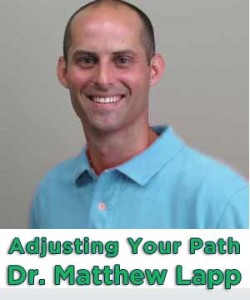Taking a closer look at simple way to help improve your health and well-being
By Dr. Matthew Lapp, Columnist, The Times
 Take control of your well-being one breath at a time.
Take control of your well-being one breath at a time.
When was the last time that you thought about your breath? I presume that if you’re reading this article you’re also breathing, but it’s a process that we often take for granted. Now that I’ve directed your attention towards your breathing, you may notice frequency or depth. It may be fast or slow. Shallow or deep. Either way, chances are that in the last ten seconds it’s been altered simply because you directed your attention there.
For over 5,000 years, yogis have been teaching their students how to breathe in order to achieve greater levels of inner awareness, peace, and well-being. Several recent studies have shown that breathing for health and wellness can even lead to benefits for people who suffer from panic attacks, asthma, high blood pressure, as well as a multitude of immunological ailments. In addition, independent studies have shown that various types of breathing exercises decrease cortisol (a hormone that’s released when your body is under stress), enhance brain function, ease symptoms of Post Traumatic Stress Disorder, and decrease anxiety and depression. I bet you never knew that you had all that healing power inside!
Some of the most interesting research so far has come out of the field of biofeedback. Biofeedback is the process of gaining greater awareness of internal processes, like heart rate, brain wave activity, muscular activity and breathing rate, in order to learn how to alter them in order to achieve greater health and performance. Often, people undergoing biofeedback training use advanced equipment in order to monitor these physiological parameters, but you can use a simple watch with a second hand. To try it for yourself, simply count the number of breaths you take in a minute and write it down. Now try it again, but take a breath or two less. Write that number down. Do it once more and again take a breath or two less. That’s it. You’ve just completed your first round of biofeedback.
Any time you consciously pay attention to a physiological process and then alter it, you are essentially performing biofeedback. The trick is to be aware of what’s going on internally, more of the time. If you can be aware of it, you can change it! And in doing so, you might be able to decrease your overall stress level and increase your level of health and well-being.
Now for one more, slightly more complex breathing activity to further enhance your ability to pay attention to your breathing. This simple exercise comes from a discipline called SomatoRespiratory Integration (SRI). Somato- means “body.” Respiratory refers to the breath, and integration is where we put it all together. Simply put, SRI is a discipline that combines breathing and body awareness exercises in order to enhance internal strategies for living a life of well-being. Overall, SRI consists of 12 stages that correlate with a book written by Dr. Donald Epstein called, The Twelve Stages of Healing. The first stage is all about connection.
To perform this exercise, simply put one hand on top of the other and place it at the center of your chest. Take a few easy breaths, in through the nose and out through the mouth. Next move your hands a little lower, to the spot where your rib cage comes together. Again take a few easy breaths. Lastly, move your hands directly over your belly button and take a few breaths. Did one spot seem easier than the others? Did one spot seem more challenging?
Try to identify both the easiest and the most challenging spot to breath into. When you’ve identified each location, place your hands over the spot that felt the easiest and most “connected” to your breath. Take a few breaths at that location. Next, move your hands to the spot that felt more difficult and breath here a few times. While you breath into this spot, say to yourself, “sometimes I feel disconnected.” As you do, imagine trying to push your hands up and out with each breath. Continue to move back and forth between the spot of “ease” and the spot of “challenge.” Take 1-3 breaths in each location until both spots feel about the same.
Now that you’ve completed the exercise, check back in with yourself and see if you notice any changes. Maybe you feel more relaxed or more aware of your body or breath? Do you notice anything new that you hadn’t noticed before? Continue to practice this exercise regularly. As you do, you’ll begin to notice more and more about your breathing, your body, and your internal state. And, the next time that you feel yourself getting overly stressed or on the verge of an over-reaction, take a few deep breaths and revel in the knowledge that you have the ability to rest, recover, and relax, all while simply breathing.
Matthew Lapp, MS, DC is the owner of Salus Chiropractic Studio in Thorndale. For more information, visit him on the web at http://www.thorndalechiropractor.com/.







Thanks Matt
Thank You for reading the article Suzanne!